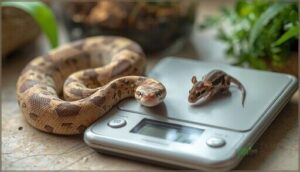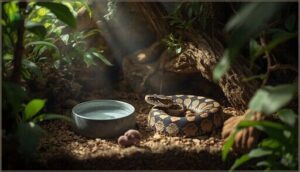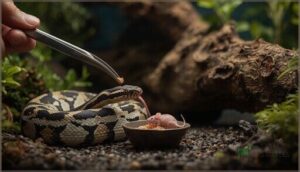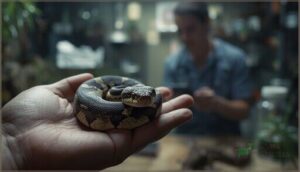This site is supported by our readers. We may earn a commission, at no cost to you, if you purchase through links.
Your baby boa just arrived, and you’re staring at the frozen rodents in your hand, wondering if you’ve got the right size—or even the right species. Get it wrong, and you risk regurgitation, nutrient deficiencies, or worse: a snake that refuses to eat for weeks.
The best food for baby boa constrictors isn’t just about grabbing any rodent from the pet store freezer. It’s about matching prey type to your boa’s size, ensuring proper calcium ratios, and establishing feeding habits that support steady, healthy growth.
Tiny neonates need fuzzy mice, while slightly larger juveniles graduate to hopper mice or even rat pinkies for that extra calcium boost. This guide walks you through choosing the right prey, preparing it safely, and recognizing when your feeding routine needs adjustment.
Table Of Contents
Key Takeaways
- Feed your baby boa frozen-thawed rodents sized to match its widest body point, choosing fuzzy mice, hopper mice, or rat pinkies for balanced nutrition and safety.
- Stick to a feeding schedule of every 7–10 days, adjusting intervals as your boa grows and monitoring for seasonal changes in appetite.
- Always use long, soft-tipped tongs for feeding and thaw prey safely to prevent injury, stress, and bacterial risks.
- Track your boa’s weight and feeding habits closely, and consult a reptile vet if you notice persistent feeding refusal, sudden behavior changes, or abnormal growth.
Best Foods for Baby Boa Constrictors
Feeding your baby boa the right food sets the foundation for healthy growth and a strong immune system. The best prey options are small, appropriately sized rodents that match your snake’s current body width.
Let’s look at the most recommended prey types and what makes each one a safe choice for your young boa.
Recommended Prey Types (Fuzzy Mice, Hopper Mice, Rat Pinkies)
Your baby boa’s diet should focus on three starter prey types: fuzzy mice, hopper mice, and rat pinkies. Fuzzy mice work well for the tiniest neonates, offering balanced nutrition as your boa outgrows pinkie mice. Hopper mice—weighing 8 to 12 grams—suit slightly larger juveniles. Rat pinkies provide nearly double the calcium of mouse-based prey, supporting strong bone growth and laying the groundwork for a rat-based diet later.
Young boas require proper prey size to avoid regurgitation.
Frozen-Thawed Vs. Live Prey
Once you’ve chosen appropriate prey size, you’ll face a critical safety decision: frozen-thawed rodents versus live prey. Feeding baby boas frozen-thawed options eliminates 90% of physical trauma events and cuts parasite transmission by over 80%. Here’s why frozen-thawed wins for prey safety and feeding ethics:
Frozen-thawed rodents eliminate 90% of trauma risks and cut parasite transmission by over 80% compared to live prey
- Zero bite risk – Live rodents can injure your boa’s mouth and eyes
- Better rodent quality control – You know exactly what you’re feeding
- Reduced disease transmission – Freezing inactivates most parasites
- Easier handling techniques – No escaped feeders in your home
Live prey increases injury risk by 24% and infection rates by 13% compared to frozen options. Understanding responsible snake care is essential for making informed decisions about your pet’s diet.
Nutritional Value of Common Prey
Frozen prey packs nutrients your boa needs, but not all feeders deliver equal value. Fuzzy mice contain 54-60% protein and 25-30% fat—ideal for rapid growth. Hopper mice offer similar protein sources, while rat pinkies contribute 58% protein with slightly less fat content.
Here’s what you’re actually feeding:
| Prey Type | Protein | Fat | Ca:P Ratio |
|---|---|---|---|
| Fuzzy Mice | 54-60% | 25-30% | 1.5-2:1 |
| Hopper Mice | 54-60% | 25-30% | 1.5-2:1 |
| Rat Pinkies | 58% | 27% | 1.5-2:1 |
| Pinkie Mice | 13% | 30% | 0.79:1 |
Commercial rodents often lack vitamin D, risking bone problems over time. Prey diversity prevents vitamin deficiencies—rotating between mice and rats improves nutrient balance. The protein-fat ratio in fuzzy and hopper mice fosters healthy muscle development without excess weight gain.
Calcium levels matter too. A proper Ca:P ratio of 1.5:1 or higher prevents metabolic bone disease, but pinkie mice fall short at 0.79:1. That’s why vitamin supplementation becomes necessary if you’re feeding younger prey items exclusively. Meeting the nutritional needs of boas means understanding prey nutritional value beyond just size.
Determining The Right Prey Size
Getting the prey size right is one of the most important decisions you’ll make when feeding your baby boa. Too large, and you risk serious injury or regurgitation. Too small, and your snake won’t get the nutrition it needs to grow properly.
Matching Prey to Boa’s Body Width
Your baby boa’s widest body point is the perfect measuring stick for choosing prey size. Visual prey sizing makes feeding safe and simple. Here’s how to match prey to body width:
- Select prey equal to or slightly narrower than your boa’s thickest section
- Look for a visible but modest lump after feeding—not a massive bulge
- Avoid prey exceeding 1.5 times your snake’s mid-body width
- Watch for easy swallowing under ten minutes
Safe Weight and Size Guidelines
The golden rule caps prey weight at 10–15% of your boa’s body mass per feeding. A 100-gram juvenile tolerates 10–15 grams safely—think hopper mice. Exceeding this prey weight ratio triggers impaction risk and regurgitation signs within 24 hours.
Track weight monitoring weekly using a kitchen scale. Gradual increases of no more than 10 grams per meal protect body condition while promoting healthy growth through safe handling practices.
Risks of Over- or Undersized Prey
When prey selection goes wrong, your baby boa pays the price through serious digestive issues and health consequences. Overfeeding risks and underfeeding signs both create problems that compound over time.
Here’s what happens with incorrect prey size:
- Regurgitation risks jump to 20% with oversized meals, causing dangerous dehydration and potential organ damage within 3–5 days
- Impaction dangers account for 12% of boa emergencies when meals exceed safe parameters
- Growth impact shows 40% reduced skeletal development from consistently undersized prey
- Stress effects increase cortisol 29% after failed feeding attempts, triggering long-term behavioral issues
Feeding Frequency and Schedule
Getting the feeding schedule right is one of the most important parts of raising a healthy baby boa. Feed too often and you risk obesity, but wait too long and your snake may not grow properly.
Let’s break down exactly how often to feed your baby boa and when to adjust that schedule as it matures.
Weekly Feeding Guidelines for Baby Boas
You’ll want to feed your baby boa every 7–10 days to match its digestion timeframes and prevent regurgitation risks. Weekly feeding with frozen-thawed rodents promotes steady growth without overfeeding.
Consistent schedules help you track weight monitoring and adjust intervals as needed. This approach balances nutrition with safety, giving your boa time to fully digest before the next meal.
Adjusting Frequency as Your Boa Grows
As your boa matures from hatchling to juvenile, you’ll gradually extend feeding intervals to match its slowing growth rate. Hatchling feeding every 7–10 days shifts to juvenile intervals of 10–14 days by six months, then adult spacing of 2–4 weeks after two years.
These gradual transitions prevent obesity while supporting healthy development. Weight monitoring helps you fine-tune feeding adjustments at each growth stage.
Factors Affecting Feeding Intervals (Metabolism, Season)
Your baby boa’s metabolism isn’t a constant—it fluctuates with temperature and seasonal variation. Metabolic rate drops 20–40% in winter, extending intervals to 4–8 weeks as digestion slows.
Warmer months accelerate growth rate and activity levels, demanding weekly feedings. Individual variation means some juveniles need adjustments beyond averages.
Inconsistent intervals disrupt physiological rhythms, so match feeding to your boa’s temperature gradient and seasonal changes.
Safe Feeding Techniques for Baby Boas
Feeding your baby boa safely isn’t complicated, but a few smart techniques can prevent stress and injuries for both of you. The right approach keeps your snake calm and protects your fingers from accidental bites.
Let’s walk through the essential methods that make feeding time safe and successful.
Thawing and Preparing Frozen Rodents
Thawing frozen rodents the right way protects both you and your baby boa from serious bacteria risks. Handling frozen-thawed rodents safely means following proven thawing procedures that prevent cross-contamination while keeping your snake healthy.
Here’s how to prepare frozen rodents correctly:
- Thaw overnight in the fridge at 40°F in a sealed bag to minimize bacterial growth
- Warm in lukewarm water (98°F) for 10–20 minutes before feeding
- Never store with human food—use dedicated containers for boa health
- Discard uneaten prey immediately—never refreeze thawed rodents
- Wash hands thoroughly after handling frozen-thawed rodents to prevent salmonella spread
Proper thawing temperatures and safe procedures reduce digestive upsets and regurgitation.
Using Tongs for Safe Feeding
Long feeding tongs—at least 12 inches—cut your bite risk by 95% and prevent accidental strikes. Soft-tipped tongs protect your baby boa’s mouth while lifting prey above substrate, reducing ingestion issues by 70%.
This handling technique gives you control and confidence, lowering stress for both you and your snake. Wiggle the prey gently to trigger natural feeding responses and improve strike success rates.
Creating a Stress-Free Feeding Environment
You’ve mastered handling technique with tongs—now turn to your boa enclosure itself. Solitary housing with visual barriers and two secure hides cuts stress by half. Dimmed lighting mimics dusk and sharpens feeding response.
Keep ambient temperature at 87–90°F and humidity levels steady at 55–70%. A consistent routine, clean substrate choice, and minimal pre-feeding handling make stress reduction straightforward and reliable.
Monitoring Growth and Health
Tracking your baby boa’s growth isn’t just about watching it get bigger. It’s about catching problems early and making sure your feeding routine is actually working.
Let’s look at the key signs that tell you whether your boa is thriving or needs adjustments.
Keeping a Feeding and Weight Log
Tracking every meal creates a Data-Driven Husbandry foundation you can trust. Your feeding log and weight monitoring system should capture prey type, meal dates, and biweekly weight checks—simple entries that enable Early Intervention when growth stalls.
This practice aids Mortality Reduction and provides Veterinary Insights during checkups. Seasonal Adjustments become clearer when you spot patterns, making data tracking your most reliable tool for raising a healthy boa.
Signs of Healthy Growth Vs. Overfeeding
Once you’ve logged a few weeks of data, you can assess whether your boa is thriving or overdoing it. A healthy growth pattern shows a square body shape with flat sides, visible muscle tone, and smooth skin condition. Weight metrics should climb steadily without dramatic spikes.
Behavior signs like active exploration confirm you’re avoiding overfeeding risks. Weight monitoring and body condition checks reveal if you’re on track.
Recognizing Digestive or Feeding Problems
How do you know something’s gone wrong? Regurgitation between days three and five signals digestive issues, often from oversized prey. Feeding refusal for two consecutive meals warrants veterinary advice.
Watch for weight loss, diarrhea, or bloating—these hint at gut health problems and possible nutrition deficits.
Chronic digestive problems increase mortality risk, so don’t wait to address signs of overfeeding and underfeeding.
When to Seek Veterinary Advice
Even the most attentive boa keeper will face situations that need professional eyes. Knowing when to call your reptile vet can mean the difference between a quick fix and a serious health problem.
Let’s look at the warning signs that mean it’s time to pick up the phone.
Persistent Feeding Refusal
If your baby boa skips three or more meals over a month, it’s time to call your vet. Persistent refusal isn’t just stubborn behavior—it often signals deeper issues that need professional eyes.
Common feeding refusal causes include:
- Temperature or humidity problems (responsible for over 40% of cases)
- Relocation stress within the first two weeks of moving
- Bacterial or parasitic infections detected in 12–18% of prolonged cases
- Wrong prey size or type flagged by experienced breeders
- Too much handling or crowded living conditions
Most refusals clear up within six weeks with simple husbandry tweaks. But don’t wait it out indefinitely. Your vet can run fecal tests, check for dehydration, and review your setup to pinpoint the real problem. With proper intervention—whether it’s adjusting temperatures, treating infections, or trying assist feeding—about 88% of baby boas bounce back and start eating on their own within two months.
Catching feeding behavior changes early makes all the difference. Appetite shifts that last beyond a few weeks warrant assessment, especially if your boa’s losing weight. Refusal prognosis is excellent when you act quickly, but delaying can lead to serious boa nutrition deficits. Force feeding risks increase the longer the issue drags on, so early refusal intervention protects your snake’s long-term health. Feeding adjustments guided by a reptile vet give your baby boa the best shot at recovery.
Unusual Behavior or Weight Changes
Your boa’s behavior tells a story—and sudden shifts deserve attention. Lethargy lasting more than a week appears in 12% of cases brought to vets, while weight swings exceeding 10% within a month signal trouble. Aggressive behavior spikes, abnormal posturing, or feeding refusal beyond three meals all warrant professional evaluation.
| Warning Sign | What to Watch For | When to Act |
|---|---|---|
| Sudden Lethargy | Activity drops 30%+ over two weeks; reduced nocturnal movement | After 7 days of unexplained inactivity |
| Weight Fluctuations | Loss exceeding 10% baseline in 4 weeks; rapid gain over 15% | Immediate evaluation for losses; assess gains against growth curves |
| Aggressive Behavior | Unprovoked striking, hissing, or defensive posturing within 48 hours | When irritability persists beyond environmental adjustments |
| Feeding Refusal | Skipping meals after consistent acceptance; regurgitation rates at 8% | After third missed meal or single regurgitation event |
| Abnormal Posturing | Star-gazing, uncoordinated crawling, muscle tremors, or persistent glass-pressing | First occurrence of neurological symptoms |
Body condition monitoring catches problems early. Weight fluctuations, appetite shifts, and feeding behavior changes often appear before visible illness. Signs of overfeeding include rapid weight spikes and lethargy, while underfeeding shows as weight stasis—no gain for three consecutive feedings affects 10% of monitored juveniles.
Preventative Health Checks for Baby Boas
Routine veterinary care isn’t reactive—it’s your best defense. Schedule your baby boa’s first health screening within two weeks of bringing them home, then follow up every six months. These checkups catch problems you’d miss at home.
- Parasite control through fecal testing detects infections in 18-27% of young boas
- Weight monitoring tracks growth rates and flags digestive health concerns early
- Dietary assessment ensures your feeding plan promotes proper development
- Growth monitoring identifies nutritional gaps before health complications arise
Frequently Asked Questions (FAQs)
Can baby boas eat insects or amphibians?
While wild youngsters might snatch a frog or cricket, your baby boa needs more than nature’s appetizers. Insects lack nutritional value, and amphibians carry parasite risks.
Stick to rodent diets—proper prey items guarantee healthy growth without supplementation needs.
How does humidity affect a baby boas appetite?
Humidity levels between 55–75% support healthy appetite and digestive health in baby boas. Low humidity can trigger appetite shifts and feeding refusal, while proper environmental factors maintain hydration needs and stimulate consistent appetite behavior.
Should I supplement my baby boas diet?
You don’t need routine vitamin supplementation if you’re feeding diverse, quality prey. However, commercially bred rodents can lack vitamin D.
Gut-loading prey or occasional calcium dusting helps prevent nutritional deficiencies without overdoing it.
What lighting conditions promote healthy eating habits?
To promote healthy eating, keep a steady photoperiod—about 13 hours of light, 11 of darkness.
UVB exposure and proper light intensity support circadian rhythm, feeding patterns, and thermoregulation.
Combine this with a temperature gradient for best results.
How do I transition between prey types?
To switch prey types for Baby Boas, match prey size to body girth and use scenting techniques like bedding transfer.
Monitor acceptance rates and track defecation, adjusting for growth stages.
Seek veterinary intervention if feeding refusals persist.
Conclusion
The choices you make now set the stage for your boa’s future health. Each meal, each adjustment, shapes a snake that grows strong and confident. By understanding the best food for baby boa, you’re not just feeding a reptile—you’re building a foundation for years of thriving companionship.
Watch for subtle changes, trust your observations, and don’t hesitate to seek help if needed. Good husbandry today means a healthy, vibrant boa tomorrow—one that rewards your careful attention at every turn.
- https://www.petmd.com/reptile/boa-constrictor-care-sheet
- https://www.wilbanksreptiles.com/blogs/taking-care-of-boa-constrictor/expert-tips-for-boa-constrictor-pet-care
- https://reptifiles.com/boa-constrictor-care/what-do-boa-constrictors-eat/
- https://www.animalsathome.ca/boa-constrictor-feeding-chart/
- https://www.youtube.com/watch?v=QN74XKZb2D4














